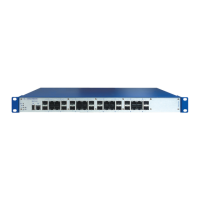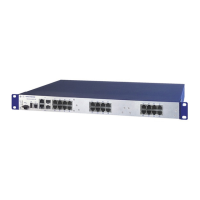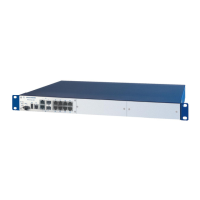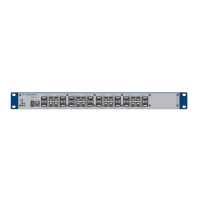Ring Redundancy
Redundanz L2P
Release
5.0
04/09
3.2
Example of MRP-Ring
33
Note: For all devices in an MRP-Ring, activate the MRP compatibility in the
Rapid Spanning Tree:Global dialog if you want to use RSTP in the
MRP-Ring. If this is not possible, perhaps because individual devices do not
support the MRP compatibility, you deactivate the Spanning Tree protocol at
the ports connected to the MRP-Ring. Spanning Tree and Ring Redundancy
affect each other.
Note: If you want to configure an MRP-Ring using the Command Line Inter-
face, you must define an additional parameter. When configured using CLI,
an MRP-Ring is addressed via its MRP domain ID. The MRP domain ID is a
sequence of 16 number blocks (8-bit values). Use the default domain of 255
255 255 255 255 255 255 255 255 255 255 255 255 255 255 255 for the MRP
domain ID.
This default domain is also used internally for a configuration via the Web-
based interface.
Configure all the devices within an MRP-Ring with the same MRP domain ID.
If VLANs are configured, you make the following selections in the
“VLAN” frame:
- VLAN ID 0, if the MRP-Ring configuration is not to be assigned to
a VLAN, as in this example.
Note the VLAN configuration of the ring ports. Select VLAN ID 1 and
VLAN membership Untagged in the static VLAN table for the ring
ports.
- a VLAN ID >0, if the MRP-Ring configuration is to be assigned to
this VLAN.
Enter this VLAN ID in the MRP-Ring configuration for all devices in
this MRP-Ring.
Note the VLAN configuration of the ring ports. For all ring ports in this
MRP-Ring, select this VLAN ID and the VLAN membership Tagged
in the static VLAN table.
enable
Switch to the Privileged EXEC mode.
configure Switch to the Configuration mode.
mrp new-domain default domain Create a new MRP-Ring with the default domain
ID
255,255,255,255,255,255,255,255,255,255,255,
255,255,255,255,255.

